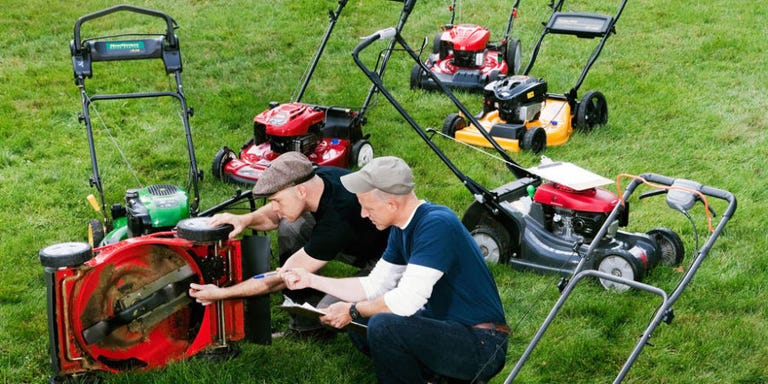
TORQUE: 7 lb-ft
DRIVE: Rear-wheel
DRIVE CONTROL: Fixed-handle; right-hand peed-control lever
NOISE: 93 dbA
Likes: "A sweet ride." That's how TROY-BILT LAWN MOWER described the quick-clipping Craftsman. One example of its smart design is the spring-loaded height adjustment. Pull up on the large red grip at each wheel and pivot to the correct height setting. Let go of the handle, and the height-adjustment pin snaps sharply into its hole. Other nice details include the well-shielded drive belt under the deck and a responsive squeeze-handle drive lever.
Dislikes: Louder than other mowers. Grass built up under the deck, at the rear mulch plug, though it didn't interfere with mowing. (We also tested the $500 Craftsman 37103. We found it pleasant and clean-cutting, but too slow for our tastes.)
Note: This mower has been discontinued, but the Craftsman 37830 is available and offers similar performance.
TORQUE: 6.25 lb-ft
DRIVE: Front-wheel
DRIVE CONTROL: Fixed-handlebar; speed-control bar
NOISE: 92 dbA
Likes: Easy starts. The key-ignition option worked well, and the mower started almost as easily with a pull.
Dislikes: We reviewed two of these mowers and found the rear-wheel brackets on both to be flimsy. In fact, one of these brackets broke right out of the box. We welded it. We also found that the drive belt under the deck was poorly protected—an hour's worth of cutting left the belt area plugged. In the past, Poulan Pro products have tested out as rugged and reliable, but not this mower.
TORQUE: 8.3 lb-ft
DRIVE: Rear-wheel
DRIVE CONTROL: Fixed-handle; dual-thumb speed-control lever
NOISE: 89 dbA
Likes: The luxury car of walk-behind lawnmowers. The Honda leaves a velvet finish, thanks to a unique dual blade and a domed plastic deck that keeps the clippings suspended as they are cut and recut. The mower stays unusually clean as it cuts, both in wet and dry grass, or even as it plows through a pile of dry leaves. Niceties include a large fuel cap that's easy to turn and tool-free air-filter access.
Dislikes: Someday, Honda will redesign the deck-lift levers, which are small and uncomfortable to use. In the meantime, they mar an otherwise outstanding machine.


